Pulling together Pulling together Pulling together
At the 1936 Olympic Games in Berlin, the UW crew made history and set a legacy in motion.
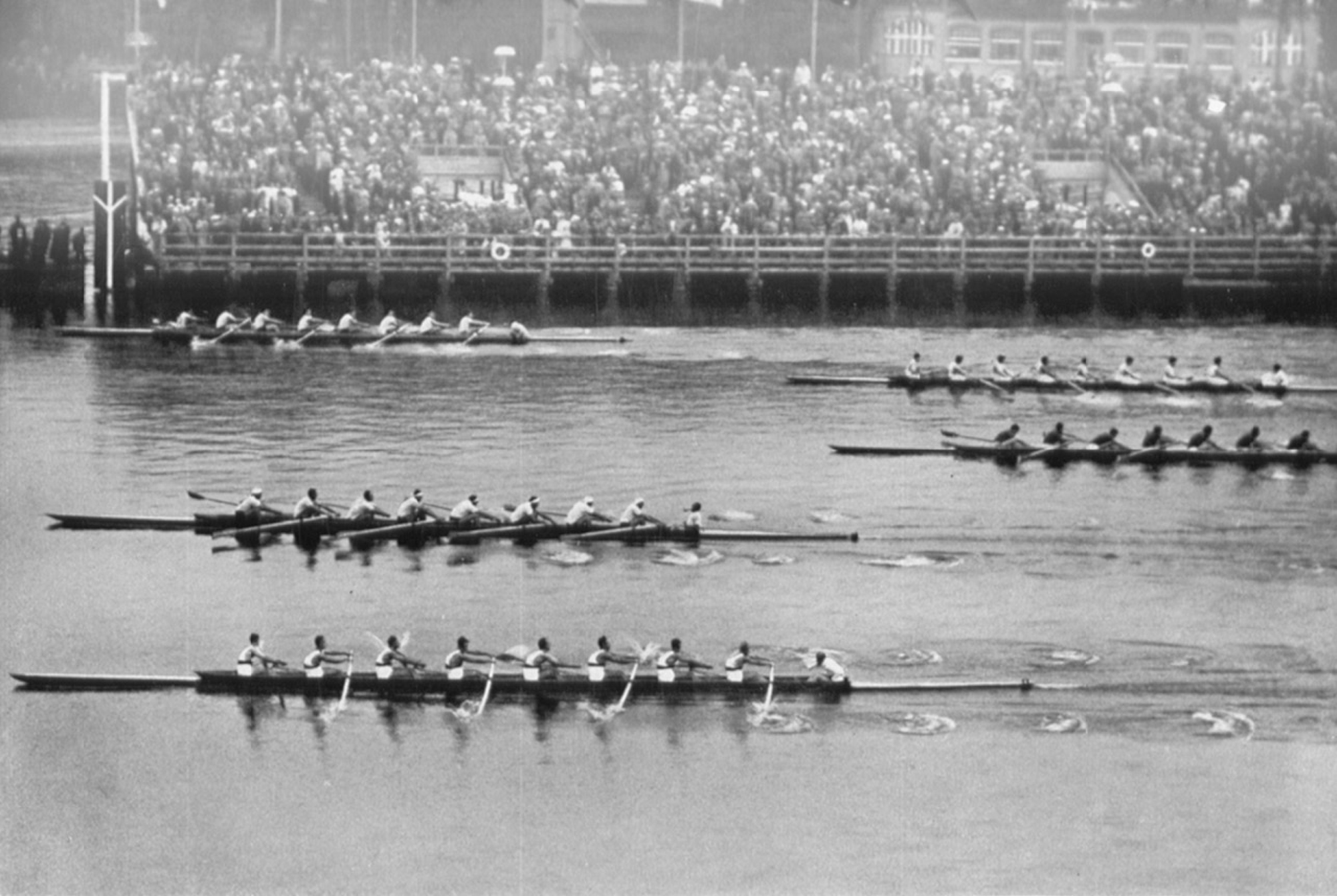
At the 1936 Olympic Games in Berlin, the UW crew made history and set a legacy in motion.
August 14, 1936. In the German community of Grünau, 75,000 spectators packed the shores of the Langer See, weathering the wind and rain to watch the final rowing event of the Berlin Olympics. Overlooking them all from a prominent balcony were Adolf Hitler and his entourage, who had arrived earlier that afternoon to cheers and salutes from the mostly German crowd.
In the United States and Europe, there had been calls to boycott the Olympics in protest of the oppression of German Jews, though those efforts hadn’t prevailed. Now the U.S. and its future allies aimed to bring symbolic opposition through their Olympic might. It was an especially tall order in the rowing events.
Germany had already won gold in five out of six rowing finals that day. Anticipation grew as six nations’ boats lined up for the most prestigious race of all: the eights, with a coxswain and eight oarsmen in each shell.
Representing the U.S. was a group of University of Washington student-athletes, young men from working-class backgrounds and small towns in Washington state, facing the biggest moment of their lives.
What “the boys in the boat” achieved in that race is legendary. So are the odds they overcame, the historical moment and the values they embodied and inspired—values shared by Huskies to this day.
The starter shouted, “Partez!” and dropped his flag. The race had begun.
* * *
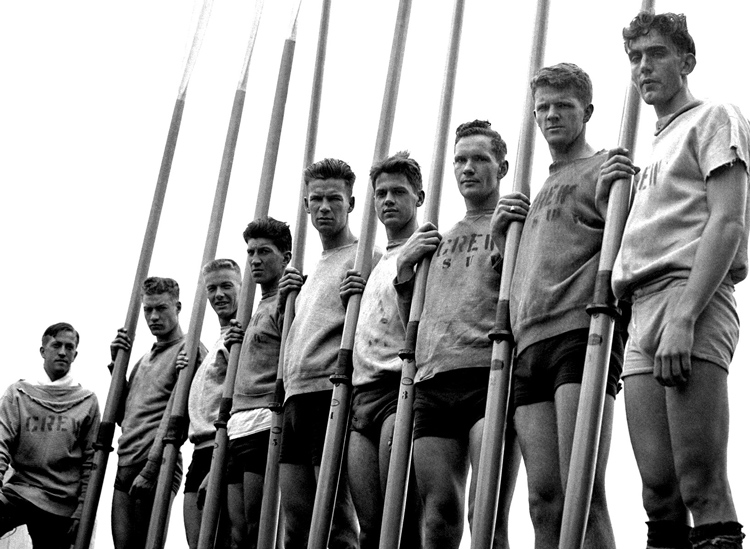
The never-defeated UW varsity eight (from left): Bobby Moch, Don Hume, Joe Rantz, George “Shorty” Hunt, Jim “Stub” McMillin, Johnny White, Gordy Adam, Chuck Day, Roger Morris.
Every fall in Seattle, young men would gather at the Associated Students of UW (ASUW) Shell House, perched on the point where Montlake Cut meets Lake Washington’s Union Bay, for their first day of crew practice.
Built as a U.S. Navy seaplane hangar near the end of World War I, the Shell House was sold to the UW for $1 soon after the war, to become the new home of the UW rowing team.
Aspiring rowers would have been awed by the imposing 12,000-square- foot structure, its massive sliding doors opening onto the Cut. Stacked within were racing shells, the longest of them—the eights—measuring 60 feet.
Inside, rowers-to-be would have been met by the smells of varnish and western red cedar. If they stayed late after practice, they might have heard legendary shell builder and rowing sage George Pocock sanding away in his upstairs workshop, where he made his living building shells not just for the UW but for virtually every rowing team in the U.S.
The Shell House was a place alive with possibility, where Pocock designed and crafted cutting-edge rowing shells, and where head coach Al Ulbrickson and freshman coach Tom Bolles molded young men of raw athletic ability into crews that won championships.
That same sense of possibility is palpable at the Shell House even today—which is why the UW community is pulling together to restore the structure. Once completed, it will be an inspirational gathering place on the water’s edge that connects campus and community, a place to reflect on our shared past as we continue moving forward.
* * *
In the leadup to the 1936 season, UW coach Ulbrickson knew his team had more than enough talent to win a national championship and maybe even Olympic gold. But it was up to him to find the right combination of men who rowed even better together—a sum greater than its parts.
The young men who most impressed Ulbrickson had grown up quickly in Depression-wracked timber towns, mining camps and dairy farms. They earned money for school by working in pulp mills, on the docks, on fishing boats and even on the Grand Coulee Dam. Higher education was their path to a different life. And at the UW, it didn’t matter where they came from. What mattered was what they were becoming.
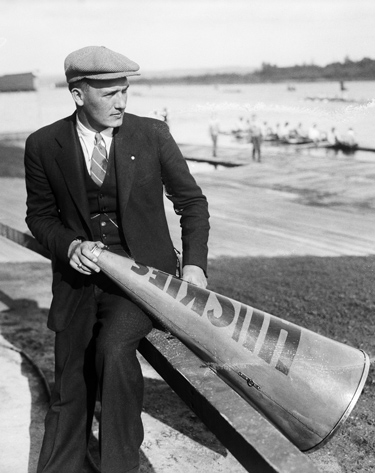
Al Ulbrickson was the UW rowing head coach for more than 30 years. His teams won six national championships, two Olympic gold medals and an Olympic bronze.
After much lineup experimentation, Ulbrickson finally found his perfect combination: Bobby Moch at coxswain, Donald Hume at stroke, then Joe Rantz, George Hunt, Jim McMillin, Johnny White, Gordon Adam and Charles Day, with Roger Morris in the bow seat. This was a hardscrabble bunch, mentally and physically tough from years of manual labor and dogged perseverance.
Ulbrickson declared them the Washington varsity eight. They would never lose a race together.
In the 1936 regular season, the varsity eight made their case as one of Washington’s all-time great crews, but what came next made them legends. After soundly beating the University of California in the Pacific Coast Regatta, Washington traveled to Poughkeepsie for the Intercollegiate Rowing Association National Championship Regatta, where they came from behind to claim the title, defeating Cal and several elite East Coast schools. Then it was on to Princeton for the Olympic trials, where they once again came from behind to win against the top crews in the country.
The UW varsity eight was headed to Berlin. But first, someone had to pay for it.
The American Olympic Committee (AOC) stunned the UW with the news that the team had to pay their own way—with less than a week to come up with the $5,000 (roughly $100,000 in today’s dollars) to cover their trip. Otherwise the AOC would send Penn, which had finished second in the trials and had ample funding.
The Seattle Times and Seattle Post- Intelligencer helped spread that news, and the Times gave a lead gift of $500, spurring the community to action. Volunteers made phone calls and solicited donations on the streets of Seattle. Loyal fans stepped up with donations ranging from 5 cents to several hundred dollars.
Within two days, the Husky community, which had already helped pay for the team’s travel to Poughkeepsie and Princeton, once again came through, ensuring the Washington eight would represent the U.S. and compete for the gold. It was a community spirit that abides today.
* * *
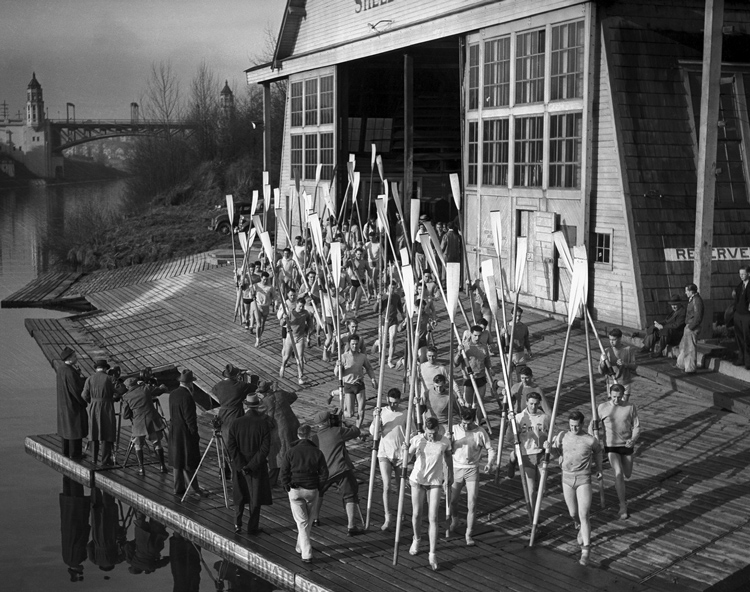
Rowing was one of the nation’s most popular sports in the 1930s. Reporters in Seattle closely followed the UW’s competitive teams.
In the Olympic final on the Langer See on that blustery evening, the men from Washington found themselves in last place. It wasn’t just that they got off to a slow start. Though they’d won their qualifying heat two days earlier— setting world and Olympic records in the process—they had been placed in the worst lane, exposed to a driving crosswind for much of the course, while Germany and Italy had been awarded the two most protected lanes.
The UW boat spent the first half of the 2,000-meter race battling wind and choppy water and trying not to fall too far behind for a comeback. By 1,200 meters, they’d moved into third position.
Then, as the Langer See narrowed and their lane was finally protected from the wind, they began to claw their way back. Amid cries of “Deutschland!” from tens of thousands of German onlookers, the Americans kicked up their stroke rate, overtaking the sprinting Germans and Italians in the final 200 meters, dropping back to even—and then, in a dramatic finish, surging forward again and winning the race by about 10 feet. Washington had won the gold.
The story, of course, does not end here; it cannot be separated from its historical context. The 1936 Olympic Games were Hitler’s chance to burnish Germany’s image, portraying a unified and supposedly peaceful nation.
But when the Olympics ended, Nazi Germany’s hateful campaign of persecution and terrorization of Jewish, Romani and LGBTQ+ people, and many others, quickly escalated to ethnic cleansing and genocide. Within three years, World War II had begun.
After winning Olympic gold and then a second consecutive national championship in 1937, many of the UW rowers graduated and went on to support the war effort, working on warplanes at Boeing and filling roles such as naval doctor, Seabee and merchant marine.
After the war, they’d sometimes reunite and squeeze back into the Husky Clipper—that Pocock-built shell they’d propelled to gold years before—and row together on Lake Washington once again.
* * *
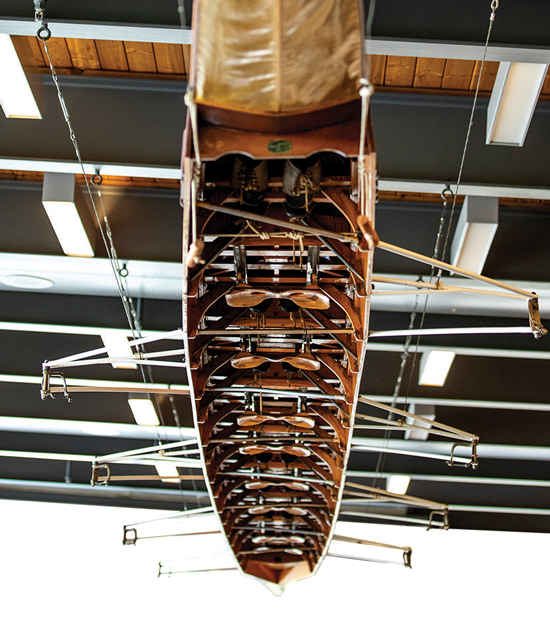
The Husky Clipper, in which the team won the Olympic gold, hangs from the rafters of Conibear Shellhouse.
Today, a decade after the publication of Daniel James Brown’s bestseller “The Boys in the Boat,” with a George Clooney film adaptation on the horizon (release and premiere dates are not yet set), the epic story of the Husky eight lives on at the UW.
“Before the book, we at the UW knew it was a great story, but now the whole world knows about it,” says UW Men’s Rowing head coach Michael Callahan, who himself rowed for Washington from 1992 to 1996. “Trust, teamwork and perseverance—Ulbrickson, Bolles and Pocock taught those values then, and we teach them today.”
The Husky Clipper currently hangs from the rafters of Conibear Shellhouse, where the UW men’s and women’s crews now train—a short walk north from the ASUW Shell House. But “The Boys in the Boat” isn’t the only story of inspiration housed in Conibear. “Young people appreciate that greatness has happened here,” says Callahan. “But they’re also here to create their own legacy.”
That they have. Just inside the south entrance is a room lined with glass cases of trophies, medals and plaques honoring the many achievements of the UW men’s and women’s rowing programs. Behind each award was a unique group of Huskies who trained hard, pulled as one and became part of a whole that was greater than the sum of its parts. And who, with the UW community’s support behind them, added another chapter to the storied history of rowing at the University of Washington.